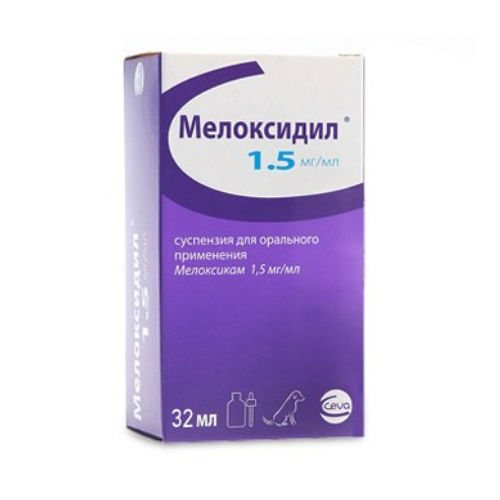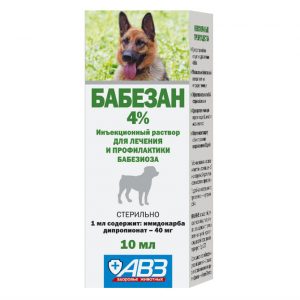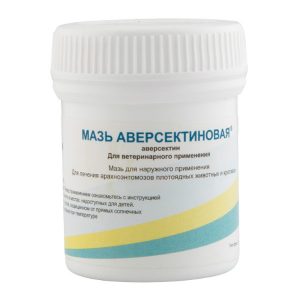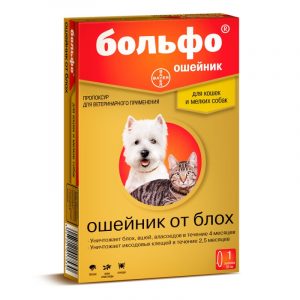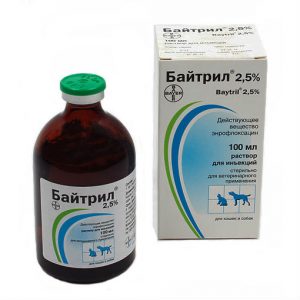Description
Pharmacological action of
Meloxidil refers to non-steroidal anti-inflammatory drugs (NSAIDs).
Meloxicam, which is part of Meloxidil, belongs to the NSAIDs of the oxycam group and has anti-inflammatory, analgesic and antipyretic effect.
The mechanism of action of meloxicam is to suppress the production of cyclooxygenase (COX) in the arachidonic acid cycle, while the production of COX-II is predominantly suppressed, which produces the synthesis of inflammatory prostaglandins (PGE1 and PGE2), which cause inflammation, swelling and pain.
After oral administration, meloxicam is well absorbed from the intestines of dogs and reaches a maximum plasma concentration within 7.5 hours the elimination half-life is 24 hours. Meloxicam is metabolized in the liver and excreted in the bile (75%) as a metabolite of glucururonic acid.
By the degree of exposure to the body, Meloxidil is a low-hazard substance (hazard class 4 according to GOST 12.1.007-76).
Composition
Meloxidil contains 0.15 g of meloxicam as an active ingredient in 100 ml, and 0.20 g of xanthan gum, 2.00 g of anhydrous colloidal silicon, 30.00 g of sorbitol, 16.00 glycerol g, xylitol 15.00 g, sodium benzoate 0.20 g, citric acid to pH 4.0 and water to 100 ml.
Dosing and Administration
Meloxidil is administered orally with food once a day at a dose of 0.2 mg / kg of meloxicam on the first day of treatment, then at a maintenance dose of 0.1 mg / kg of meloxicam for 10 days.
Before use, shake the contents of the vial until a homogeneous suspension is formed.
Each pack is equipped with two measuring syringes, which allows the most accurate dosage of the drug to small and large dog breeds. One division of a small syringe is designed for 0.5 kg of animal weight, a large syringe for 2.5 kg of animal weight, which corresponds to a daily maintenance dose of 0.1 mg / kg meloxicam.
The clinical effect occurs 3-4 days after the start of the drug. The duration of the course of treatment is determined by the veterinarian depending on the indications.
After a 10-day course of treatment, the animal must be examined by a veterinarian and, if there is no improvement in the clinical condition, the drug is discontinued.
Side effects
In recommended doses, the drug is well tolerated by dogs.
In rare cases, possible: loss of appetite, apathy, vomiting, diarrhea, hidden blood in the feces.
Side effects usually occur in the first week of treatment and in most cases pass independently after drug withdrawal.
Meloxidil is not recommended for use with other NSAIDs, glucocorticoids, diuretics, anticoagulants, aminoglycoside antibiotics and other drugs, which are characterized by a high degree of binding to serum proteins due to the likelihood of increased toxic effects of the drug.
In the absence of effectiveness of treatment with other NSAIDs, Meloxidil onmean no earlier than 24 hours after the cancellation of the previous drug under the supervision of a veterinarian.
The drug is not intended for the treatment of productive animals.
An overdose of
Meloxidil in dogs five times or more leads to a violation of the function of the mucous membrane of the gastrointestinal tract (ulcer, gastritis), manifested by vomiting and diarrhea.
In case of drug overdose, symptomatic treatment is recommended.
Use of the drug in animals in a state of dehydration, hypovolemia and hypotension are potentially dangerous, due to the possible toxic effect of meloxicam on the kidneys.
In case of emergency, when administering Meloxidil to such animals, the daily dose should be halved and careful monitoring of the clinical condition should be carried out.
If one or more doses of the drug is missed, treatment should be resumed as soon as possible in the prescribed dosages and regimen.
active substance
Meloxicam
